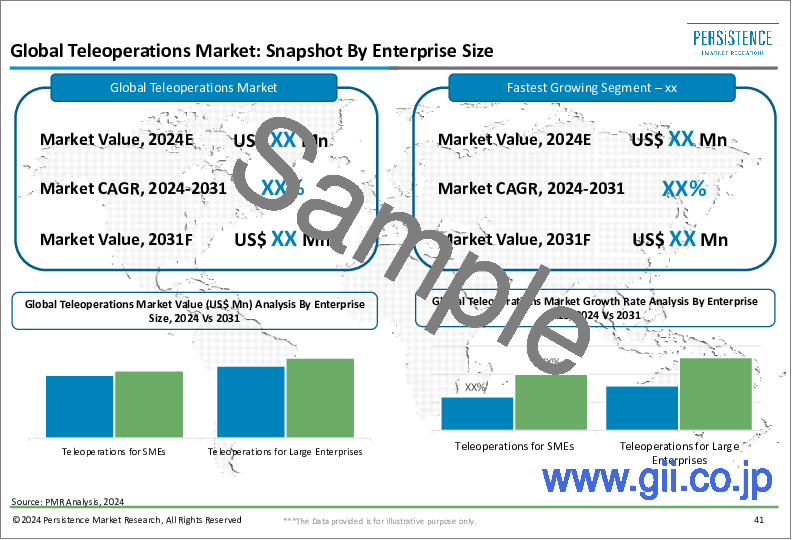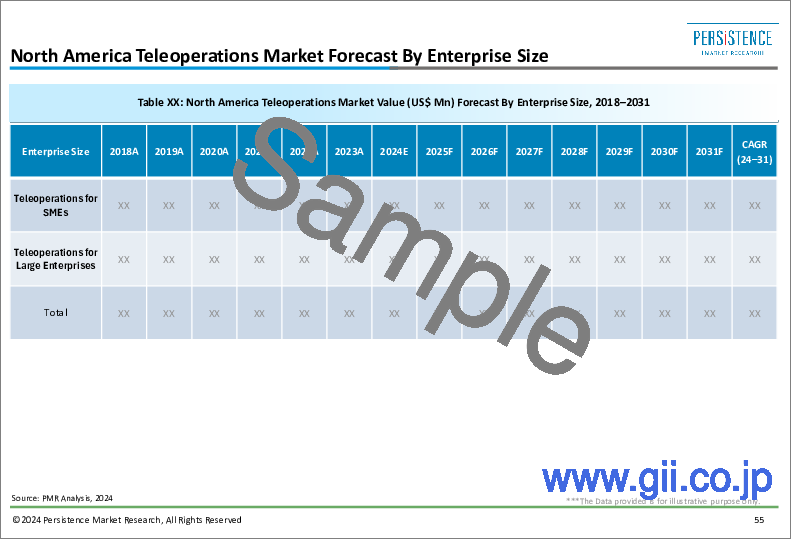|
|
市場調査レポート
商品コード
1508637
遠隔操作市場:世界の産業分析、規模、シェア、成長、動向、2024年~2033年予測Teleoperations Market: Global Industry Analysis, Size, Share, Growth, Trends, and Forecast, 2024-2033 |
||||||
カスタマイズ可能
|
|||||||
| 遠隔操作市場:世界の産業分析、規模、シェア、成長、動向、2024年~2033年予測 |
|
出版日: 2024年06月28日
発行: Persistence Market Research
ページ情報: 英文 290 Pages
納期: 2~5営業日
|
全表示
- 概要
- 目次
Persistence Market Research社はこのほど、世界の遠隔操作市場に関する包括的なレポートを発表しました。当レポートでは、市場促進要因・動向・機会・課題を含む重要な市場力学を徹底的に評価し、市場構造に関する詳細な洞察を提供しています。
主な洞察
- 遠隔操作の市場規模(2024E):6億303万9,000米ドル
- 予測市場価値(2033F):43億6,523万9,000米ドル
- 世界市場成長率(CAGR 2024年~2033年):24.6%
遠隔操作市場- 調査範囲:
遠隔操作には、機械、ロボット、車両の遠隔操作が含まれ、危険な環境、アクセスできない環境、地理的に離れた環境での操作を容易にします。この技術は、産業製造、ヘルスケア、軍事、宇宙開発、自律走行車などの分野で不可欠です。市場成長の原動力は、ロボット工学の進歩、自動化需要の増加、業務効率と安全性を高めるためのAIと機械学習の統合です。
市場促進要因:
世界の遠隔操作市場は、製造や物流における自動化需要の高まり、遠隔手術や診断のためのヘルスケアにおける遠隔操作システムの採用拡大、軍事や宇宙探査における遠隔操作車両の使用拡大など、いくつかの主要な要因によって推進されています。ヒューマン・マシン・インターフェースの改善やAIの統合といった技術の進歩が遠隔操作システムの性能と信頼性を高め、市場の成長を促進しています。さらに、作業員の安全性と作業効率への注目の高まりが、さまざまな産業での遠隔操作の採用を促進しています。
市場抑制要因:
有望な成長見通しにもかかわらず、遠隔操作市場はサイバーセキュリティリスク、高い導入コスト、技術的複雑性に関連する課題に直面しています。遠隔地にいるオペレーターと機械間の安全で信頼性の高い通信を確保することは極めて重要であり、データプライバシーやサイバー脅威からの保護という点で大きな課題となっています。さらに、遠隔操作システムのコストが高く、オペレーターの専門的なトレーニングが必要であることが、特に中小企業における市場浸透の妨げとなっています。これらの課題に対処するためには、サイバーセキュリティ対策の進歩、費用対効果の高いソリューション、包括的なトレーニングプログラムが必要であり、より広範な普及を促進する必要があります。
市場機会:
遠隔操作市場は、技術革新、インダストリー4.0の台頭、危険な環境での遠隔操作に対する需要の高まりにより、大きな成長機会をもたらしています。遠隔操作における仮想現実(VR)と拡張現実(AR)技術の統合は、ユーザー体験と精度を高め、市場拡大の新たな道を開きます。さらに、遠隔作業の動向の高まりや、COVID-19パンデミックのような世界の健康危機を受けた非接触操作の必要性が、市場成長のさらなる機会を生み出しています。戦略的パートナーシップ、研究開発への投資、スケーラブルでユーザーフレンドリーな遠隔操作ソリューションの市場開拓は、新たな機会を活用し、市場のリーダーシップを維持するために不可欠です。
本レポートで扱う主な質問
- 遠隔操作市場の世界的成長を促す主な要因は何か?
- 様々な分野で遠隔操作の採用を促進しているアプリケーションと産業は何か?
- 技術進歩は遠隔操作市場の競合情勢をどのように変えているのか?
- 遠隔操作市場に貢献している主要プレイヤーは誰で、市場の関連性を維持するためにどのような戦略を採用しているのか?
- 世界の遠隔操作市場における新たな動向と将来展望は?
目次
第1章 エグゼクティブサマリー
第2章 市場概要
- 市場範囲/ 分類
- 市場の定義/ 範囲/ 制限
第3章 主要な市場動向
- 市場に影響を与える主な動向
- 製品イノベーション/開発動向
第4章 価格分析
- 製品別の価格分析
- 平均価格分析ベンチマーク
第5章 世界の遠隔操作市場の需要(百万米ドル単位の値)分析
- 過去の市場価値(百万米ドル)分析、2019年~2023年
- 現在および将来の市場価値(百万米ドル)予測、2024年~2033年
- 前年比成長動向分析
- 絶対的なドル機会分析
第6章 市場背景
- マクロ経済要因
- 予測要因- 関連性と影響
- バリューチェーン
- COVID-19危機- 影響評価
- 市場力学
第7章 世界の遠隔操作市場分析:コンポーネント別
- イントロダクション/主な調査結果
- コンポーネント別の市場規模(百万米ドル)の過去分析、2019年~2023年
- コンポーネント別の現在および将来の市場規模(百万米ドル)の分析と予測、2024年~2033年
- ハードウェア
- HMDデバイス
- 遠隔操作装置
- その他
- 遠隔操作プラットフォーム/ソフトウェア
- サービス
- 設計・開発サービス
- コンサルティングサービス
- 統合サービス
- サポートとメンテナンス
- ハードウェア
- コンポーネント別市場の魅力分析
第8章 世界遠隔操作市場分析:企業規模別
- イントロダクション/主な調査結果
- 企業規模別の市場規模(百万米ドル)の過去分析、2019年~2023年
- 企業規模別の現在および将来の市場規模(百万米ドル)分析と予測、2024年~2033年
- 中小企業向け遠隔操作
- 大企業向け遠隔操作
- 企業規模別市場の魅力分析
第9章 世界遠隔操作市場分析:アプリケーション別
- イントロダクション/主な調査結果
- アプリケーション別の市場規模(百万米ドル)の過去分析、2019年~2023年
- アプリケーション別の現在および将来の市場規模(百万米ドル)の分析と予測、2024年~2033年
- 輸送と物流のための遠隔操作
- ヘルスケアと医療のための遠隔操作
- 軍事および公共安全のための遠隔操作
- スマートファクトリー/インダストリー4.0向け遠隔操作
- エネルギーと電力の遠隔操作
- 農業向け遠隔操作
- 他者のための遠隔操作
- アプリケーション別市場の魅力分析
第10章 世界遠隔操作市場分析:地域別
- イントロダクション/主な調査結果
- 地域別の市場規模(百万米ドル)の過去分析、2019年~2023年
- 地域別の現在および将来の市場規模(百万米ドル)分析と予測、2024年~2033年
- 北米
- ラテンアメリカ
- 欧州
- 東アジア
- 南アジア太平洋
- 中東およびアフリカ
- 地域別市場の魅力分析
第11章 北米の遠隔操作市場分析
第12章 ラテンアメリカの遠隔操作市場分析
第13章 欧州の遠隔操作市場分析
第14章 南アジア・太平洋地域の遠隔操作市場分析
第15章 東アジアの遠隔操作市場分析
第16章 中東およびアフリカの遠隔操作市場分析
第17章 主要国別の遠隔操作市場分析
- 米国
- カナダ
- メキシコ
- ブラジル
- ドイツ
- イタリア
- フランス
- 英国
- スペイン
- ベネルクス
- ロシア
- その他欧州
- 中国
- 日本
- 韓国
- インド
- マレーシア
- インドネシア
- シンガポール
- オーストラリアとニュージーランド
- GCC諸国
- トルコ
- 南アフリカ
- その他中東およびアフリカ
第18章 市場構造分析
- 企業階層別市場分析
- 主要企業の市場シェア分析
- 市場プレゼンス分析
第19章 競合分析
- 競合ダッシュボード
- 競合ベンチマーク
- 競合の詳細
- Ottopia
- Cognicept
- Voysys
- Formant
- Taurob GmbH
- Shadow Robot Company
- Scooterson
- Quantum Signal LLC
- Neya Systems
- Phantom Auto
第20章 使用される仮定と略語
第21章 調査手法
Persistence Market Research has recently released a comprehensive report on the worldwide market for teleoperations. The report offers a thorough assessment of crucial market dynamics, including drivers, trends, opportunities, and challenges, providing detailed insights into the market structure.
Key Insights:
- Teleoperations Market Size (2024E): USD 603.039 million
- Projected Market Value (2033F): USD 4365.239 million
- Global Market Growth Rate (CAGR 2024 to 2033): 24.6%
Teleoperations Market - Report Scope:
Teleoperations involve remote control of machines, robots, or vehicles, facilitating operations in hazardous, inaccessible, or geographically distant environments. This technology is vital across sectors such as industrial manufacturing, healthcare, military, space exploration, and autonomous vehicles. Market growth is driven by advancements in robotics, increasing demand for automation, and the integration of AI and machine learning to enhance operational efficiency and safety.
Market Growth Drivers:
The global teleoperations market is propelled by several key factors, including the rising demand for automation in manufacturing and logistics, growing adoption of teleoperated systems in healthcare for remote surgeries and diagnostics, and the expanding use of teleoperated vehicles in military and space exploration. Technological advancements, such as improved human-machine interfaces and the integration of AI, enhance the performance and reliability of teleoperated systems, driving market growth. Moreover, the increased focus on worker safety and operational efficiency fuels the adoption of teleoperations across various industries.
Market Restraints:
Despite promising growth prospects, the teleoperations market faces challenges related to cybersecurity risks, high implementation costs, and technical complexities. Ensuring secure and reliable communication between remote operators and machines is crucial, posing significant challenges in terms of data privacy and protection against cyber threats. Additionally, the high cost of teleoperation systems and the need for specialized training for operators hinder market penetration, especially in small and medium-sized enterprises. Addressing these challenges requires advancements in cybersecurity measures, cost-effective solutions, and comprehensive training programs to facilitate broader adoption.
Market Opportunities:
The teleoperations market presents significant growth opportunities driven by technological innovations, the rise of Industry 4.0, and the increasing demand for remote operations in hazardous environments. The integration of virtual reality (VR) and augmented reality (AR) technologies in teleoperations enhances user experience and precision, opening new avenues for market expansion. Furthermore, the growing trend of remote work and the need for contactless operations in the wake of global health crises, such as the COVID-19 pandemic, create additional opportunities for market growth. Strategic partnerships, investment in R&D, and the development of scalable, user-friendly teleoperation solutions are essential to capitalize on emerging opportunities and sustain market leadership.
Key Questions Answered in the Report:
- What are the primary factors driving the growth of the teleoperations market globally?
- Which applications and industries are driving teleoperations adoption across different sectors?
- How are technological advancements reshaping the competitive landscape of the teleoperations market?
- Who are the key players contributing to the teleoperations market, and what strategies are they employing to maintain market relevance?
- What are the emerging trends and future prospects in the global teleoperations market?
Competitive Intelligence and Business Strategy:
Leading players in the global teleoperations market, including ABB Ltd., Schneider Electric SE, Omron Corporation, and General Electric Company, focus on innovation, product differentiation, and strategic partnerships to gain a competitive edge. These companies invest in R&D to develop advanced teleoperation solutions, incorporating AI, machine learning, and VR/AR technologies to enhance performance and user experience. Collaborations with industry stakeholders, technology providers, and regulatory agencies facilitate market access and promote technology adoption. Moreover, emphasis on cybersecurity, operator training, and customer support fosters market growth and enhances operational efficiency in the rapidly evolving teleoperations landscape.
Key Companies Profiled:
- Ottopia
- Cognicept
- Voysys
- Formant
- Taurob GmbH
- Shadow Robot Company
- Scooterson
- Quantum Signal LLC
- Neya Systems
- Phantom Auto
Key Segments of Teleoperations Market Research
By Component:
- Hardware
- Teleoperation Platform/Software
- Services
By Enterprise Size:
- Teleoperations for SMEs
- Teleoperations for Large Enterprises
By Application:
- Teleoperations for Transportation & Logistics
- Teleoperations for Healthcare & Medical
- Teleoperations for Military & Public Safety
- Teleoperations for Smart Factory/Industry 4.0
- Teleoperations for Energy & Power
- Teleoperations for Agriculture
- Teleoperations for Others
By Region:
- North America
- Latin America
- Europe
- East Asia
- South Asia & Pacific
- Middle East and Africa (MEA)
Table of Contents
1. Executive Summary
- 1.1. Global Market Outlook
- 1.2. Demand Side Trends
- 1.3. Supply Side Trends
- 1.4. Analysis and Recommendations
2. Market Overview
- 2.1. Market Coverage / Taxonomy
- 2.2. Market Definition / Scope / Limitations
3. Key Market Trends
- 3.1. Key Trends Impacting the Market
- 3.2. Product Innovation / Development Trends
4. Pricing Analysis
- 4.1. Pricing Analysis, By Products
- 4.2. Average Pricing Analysis Benchmark
5. Global Teleoperations Market Demand (Value in US$ Mn) Analysis 2019-2023 and Forecast, 2024-2033
- 5.1. Historical Market Value (US$ Mn) Analysis, 2019-2023
- 5.2. Current and Future Market Value (US$ Mn) Projections, 2024-2033
- 5.2.1. Y-o-Y Growth Trend Analysis
- 5.2.2. Absolute $ Opportunity Analysis
6. Market Background
- 6.1. Macro-Economic Factors
- 6.2. Forecast Factors - Relevance & Impact
- 6.3. Value Chain
- 6.4. COVID-19 Crisis - Impact Assessment
- 6.4.1. Current Statistics
- 6.4.2. Short-Mid-Long Term Outlook
- 6.4.3. Likely Rebound
- 6.5. Market Dynamics
- 6.5.1. Drivers
- 6.5.2. Restraints
- 6.5.3. Opportunities
7. Global Teleoperations Market Analysis 2019-2023 and Forecast 2024-2033, By Component
- 7.1. Introduction / Key Findings
- 7.2. Historical Market Size (US$ Mn) Analysis by Component, 2019-2023
- 7.3. Current and Future Market Size (US$ Mn) Analysis and Forecast by Component, 2024-2033
- 7.3.1. Hardware
- 7.3.1.1. HMD Devices
- 7.3.1.2. Telemanipulator Devices
- 7.3.1.3. Others
- 7.3.2. Teleoperation Platform/Software
- 7.3.3. Services
- 7.3.3.1. Design & Development Services
- 7.3.3.2. Consulting Services
- 7.3.3.3. Integration Services
- 7.3.3.4. Support & Maintenance
- 7.3.1. Hardware
- 7.4. Market Attractiveness Analysis by Component
8. Global Teleoperations Market Analysis 2019-2023 and Forecast 2024-2033, By Enterprise Size
- 8.1. Introduction / Key Findings
- 8.2. Historical Market Size (US$ Mn) Analysis by Enterprise Size, 2019-2023
- 8.3. Current and Future Market Size (US$ Mn) Analysis and Forecast by Enterprise Size, 2024-2033
- 8.3.1. Teleoperations for SMEs
- 8.3.2. Teleoperations for Large Enterprises
- 8.4. Market Attractiveness Analysis by Enterprise Size
9. Global Teleoperations Market Analysis 2019-2023 and Forecast 2024-2033, By Application
- 9.1. Introduction / Key Findings
- 9.2. Historical Market Size (US$ Mn) Analysis by Application, 2019-2023
- 9.3. Current and Future Market Size (US$ Mn) Analysis and Forecast by Application, 2024-2033
- 9.3.1. Teleoperations for Transportation & Logistics
- 9.3.2. Teleoperations for Healthcare & Medical
- 9.3.3. Teleoperations for Military & Public Safety
- 9.3.4. Teleoperations for Smart Factory/Industry 4.0
- 9.3.5. Teleoperations for Energy & Power
- 9.3.6. Teleoperations for Agriculture
- 9.3.7. Teleoperations for Others
- 9.4. Market Attractiveness Analysis By Application
10. Global Teleoperations Market Analysis 2019-2023 and Forecast 2024-2033, by Region
- 10.1. Introduction / Key Findings
- 10.2. Historical Market Size (US$ Mn) Analysis by Region, 2019-2023
- 10.3. Current and Future Market Size (US$ Mn) Analysis and Forecast by Region, 2024-2033
- 10.3.1. North America
- 10.3.2. Latin America
- 10.3.3. Europe
- 10.3.4. East Asia
- 10.3.5. South Asia Pacific
- 10.3.6. Middle East and Africa
- 10.4. Market Attractiveness Analysis by Region
11. North America Teleoperations Market Analysis 2019-2023 and Forecast 2024-2033
- 11.1. Introduction
- 11.2. Historical Market Size (US$ Mn) Trend Analysis By Market Taxonomy, 2019-2023
- 11.3. Current and Future Market Size (US$ Mn) Forecast By Market Taxonomy, 2024-2033
- 11.3.1. By Component
- 11.3.2. By Enterprise Size
- 11.3.3. By Application
- 11.3.4. By Country
- 11.3.4.1. U.S.
- 11.3.4.2. Canada
- 11.4. Market Attractiveness Analysis
- 11.4.1. By Component
- 11.4.2. By Enterprise Size
- 11.4.3. By Application
- 11.4.4. By Country
- 11.5. Market Trends
- 11.6. Key Market Participants - Intensity Mapping
12. Latin America Teleoperations Market Analysis 2019-2023 and Forecast 2024-2033
- 12.1. Introduction
- 12.2. Historical Market Size (US$ Mn) Trend Analysis By Market Taxonomy, 2019-2023
- 12.3. Current and Future Market Size (US$ Mn) Forecast By Market Taxonomy, 2024-2033
- 12.3.1. By Component
- 12.3.2. By Enterprise Size
- 12.3.3. By Application
- 12.3.4. By Country
- 12.3.4.1. Brazil
- 12.3.4.2. Mexico
- 12.3.4.3. Rest of Latin America
- 12.4. Market Attractiveness Analysis
- 12.4.1. By Component
- 12.4.2. By Enterprise Size
- 12.4.3. By Application
- 12.4.4. By Country
13. Europe Teleoperations Market Analysis 2019-2023 and Forecast 2024-2033
- 13.1. Introduction
- 13.2. Historical Market Size (US$ Mn) Trend Analysis By Market Taxonomy, 2019-2023
- 13.3. Current and Future Market Size (US$ Mn) Forecast By Market Taxonomy, 2024-2033
- 13.3.1. By Component
- 13.3.2. By Enterprise Size
- 13.3.3. By Application
- 13.3.4. By Country
- 13.3.4.1. Germany
- 13.3.4.2. Italy
- 13.3.4.3. France
- 13.3.4.4. U.K.
- 13.3.4.5. Spain
- 13.3.4.6. BENELUX
- 13.3.4.7. Russia
- 13.3.4.8. Rest of Europe
- 13.4. Market Attractiveness Analysis
- 13.4.1. By Component
- 13.4.2. By Enterprise Size
- 13.4.3. By Application
- 13.4.4. By Country
14. South Asia & Pacific Teleoperations Market Analysis 2019-2023 and Forecast 2024-2033
- 14.1. Introduction
- 14.2. Historical Market Size (US$ Mn) Trend Analysis By Market Taxonomy, 2019-2023
- 14.3. Current and Future Market Size (US$ Mn) Forecast By Market Taxonomy, 2024-2033
- 14.3.1. By Component
- 14.3.2. By Enterprise Size
- 14.3.3. By Application
- 14.3.4. By Country
- 14.3.4.1. India
- 14.3.4.2. Indonesia
- 14.3.4.3. Malaysia
- 14.3.4.4. Singapore
- 14.3.4.5. Australia & New Zealand
- 14.3.4.6. Rest of South Asia and Pacific
- 14.4. Market Attractiveness Analysis
- 14.4.1. By Component
- 14.4.2. By Enterprise Size
- 14.4.3. By Application
- 14.4.4. By Country
15. East Asia Teleoperations Market Analysis 2019-2023 and Forecast 2024-2033
- 15.1. Introduction
- 15.2. Historical Market Size (US$ Mn) Trend Analysis By Market Taxonomy, 2019-2023
- 15.3. Current and Future Market Size (US$ Mn) Forecast By Market Taxonomy, 2024-2033
- 15.3.1. By Component
- 15.3.2. By Enterprise Size
- 15.3.3. By Application
- 15.3.4. By Country
- 15.3.4.1. China
- 15.3.4.2. Japan
- 15.3.4.3. South Korea
- 15.4. Market Attractiveness Analysis
- 15.4.1. By Component
- 15.4.2. By Enterprise Size
- 15.4.3. By Application
- 15.4.4. By Country
16. Middle East and Africa Teleoperations Market Analysis 2019-2023 and Forecast 2024-2033
- 16.1. Introduction
- 16.2. Historical Market Size (US$ Mn) Trend Analysis By Market Taxonomy, 2019-2023
- 16.3. Current and Future Market Size (US$ Mn) Forecast By Market Taxonomy, 2024-2033
- 16.3.1. By Component
- 16.3.2. By Enterprise Size
- 16.3.3. By Application
- 16.3.4. By Country
- 16.3.4.1. GCC Countries
- 16.3.4.2. Turkey
- 16.3.4.3. South Africa
- 16.3.4.4. Rest of Middle East and Africa
- 16.4. Market Attractiveness Analysis
- 16.4.1. By Component
- 16.4.2. By Enterprise Size
- 16.4.3. By Application
- 16.4.4. By Country
17. Key Countries Analysis- Teleoperations Market
- 17.1. U.S. Teleoperations Market Analysis
- 17.1.1. By Component
- 17.1.2. By Enterprise Size
- 17.1.3. By Application
- 17.2. Canada Teleoperations Market Analysis
- 17.2.1. By Component
- 17.2.2. By Enterprise Size
- 17.2.3. By Application
- 17.3. Mexico Teleoperations Market Analysis
- 17.3.1. By Component
- 17.3.2. By Enterprise Size
- 17.3.3. By Application
- 17.4. Brazil Teleoperations Market Analysis
- 17.4.1. By Component
- 17.4.2. By Enterprise Size
- 17.4.3. By Application
- 17.5. Germany Teleoperations Market Analysis
- 17.5.1. By Component
- 17.5.2. By Enterprise Size
- 17.5.3. By Application
- 17.6. Italy Teleoperations Market Analysis
- 17.6.1. By Component
- 17.6.2. By Enterprise Size
- 17.6.3. By Application
- 17.7. France Teleoperations Market Analysis
- 17.7.1. By Component
- 17.7.2. By Enterprise Size
- 17.7.3. By Application
- 17.8. U.K. Teleoperations Market Analysis
- 17.8.1. By Component
- 17.8.2. By Enterprise Size
- 17.8.3. By Application
- 17.9. Spain Teleoperations Market Analysis
- 17.9.1. By Component
- 17.9.2. By Enterprise Size
- 17.9.3. By Application
- 17.10. BENELUX Teleoperations Market Analysis
- 17.10.1. By Component
- 17.10.2. By Enterprise Size
- 17.10.3. By Application
- 17.11. Russia Teleoperations Market Analysis
- 17.11.1. By Component
- 17.11.2. By Enterprise Size
- 17.11.3. By Application
- 17.12. Rest of Europe Teleoperations Market Analysis
- 17.12.1. By Component
- 17.12.2. By Enterprise Size
- 17.12.3. By Application
- 17.13. China Teleoperations Market Analysis
- 17.13.1. By Component
- 17.13.2. By Enterprise Size
- 17.13.3. By Application
- 17.14. Japan Teleoperations Market Analysis
- 17.14.1. By Component
- 17.14.2. By Enterprise Size
- 17.14.3. By Application
- 17.15. South Korea Teleoperations Market Analysis
- 17.15.1. By Component
- 17.15.2. By Enterprise Size
- 17.15.3. By Application
- 17.16. India Teleoperations Market Analysis
- 17.16.1. By Component
- 17.16.2. By Enterprise Size
- 17.16.3. By Application
- 17.17. Malaysia Teleoperations Market Analysis
- 17.17.1. By Component
- 17.17.2. By Enterprise Size
- 17.17.3. By Application
- 17.18. Indonesia Teleoperations Market Analysis
- 17.18.1. By Component
- 17.18.2. By Enterprise Size
- 17.18.3. By Application
- 17.19. Singapore Teleoperations Market Analysis
- 17.19.1. By Component
- 17.19.2. By Enterprise Size
- 17.19.3. By Application
- 17.20. Australia and New Zealand Teleoperations Market Analysis
- 17.20.1. By Component
- 17.20.2. By Enterprise Size
- 17.20.3. By Application
- 17.21. GCC Countries Teleoperations Market Analysis
- 17.21.1. By Component
- 17.21.2. By Enterprise Size
- 17.21.3. By Application
- 17.22. Turkey Teleoperations Market Analysis
- 17.22.1. By Component
- 17.22.2. By Enterprise Size
- 17.22.3. By Application
- 17.23. South Africa Teleoperations Market Analysis
- 17.23.1. By Component
- 17.23.2. By Enterprise Size
- 17.23.3. By Application
- 17.24. Rest of Middle East and Africa Teleoperations Market Analysis
- 17.24.1. By Component
- 17.24.2. By Enterprise Size
- 17.24.3. By Application
18. Market Structure Analysis
- 18.1. Market Analysis by Tier of Companies
- 18.2. Market Share Analysis of Top Players
- 18.3. Market Presence Analysis
19. Competition Analysis
- 19.1. Competition Dashboard
- 19.2. Competition Benchmarking
- 19.3. Competition Deep Dive
- 19.3.1. Ottopia
- 19.3.1.1. Business Overview
- 19.3.1.2. Product Portfolio
- 19.3.1.3. Profitability by Market Segments (Business Segments/Region)
- 19.3.1.4. Key Strategy & Developments
- 19.3.2. Cognicept
- 19.3.2.1. Business Overview
- 19.3.2.2. Product Portfolio
- 19.3.2.3. Profitability by Market Segments (Business Segments/Region)
- 19.3.2.4. Key Strategy & Developments
- 19.3.3. Voysys
- 19.3.3.1. Business Overview
- 19.3.3.2. Product Portfolio
- 19.3.3.3. Profitability by Market Segments (Business Segments/Region)
- 19.3.3.4. Key Strategy & Developments
- 19.3.4. Formant
- 19.3.4.1. Business Overview
- 19.3.4.2. Product Portfolio
- 19.3.4.3. Profitability by Market Segments (Business Segments/Region)
- 19.3.4.4. Key Strategy & Developments
- 19.3.5. Taurob GmbH
- 19.3.5.1. Business Overview
- 19.3.5.2. Product Portfolio
- 19.3.5.3. Profitability by Market Segments (Business Segments/Region)
- 19.3.5.4. Key Strategy & Developments
- 19.3.6. Shadow Robot Company
- 19.3.6.1. Business Overview
- 19.3.6.2. Product Portfolio
- 19.3.6.3. Profitability by Market Segments (Business Segments/Region)
- 19.3.6.4. Key Strategy & Developments
- 19.3.7. Scooterson
- 19.3.7.1. Business Overview
- 19.3.7.2. Product Portfolio
- 19.3.7.3. Profitability by Market Segments (Business Segments/Region)
- 19.3.7.4. Key Strategy & Developments
- 19.3.8. Quantum Signal LLC
- 19.3.8.1. Business Overview
- 19.3.8.2. Product Portfolio
- 19.3.8.3. Profitability by Market Segments (Business Segments/Region)
- 19.3.8.4. Key Strategy & Developments
- 19.3.9. Neya Systems
- 19.3.9.1. Business Overview
- 19.3.9.2. Product Portfolio
- 19.3.9.3. Profitability by Market Segments (Business Segments/Region)
- 19.3.9.4. Key Strategy & Developments
- 19.3.10. Phantom Auto
- 19.3.10.1. Business Overview
- 19.3.10.2. Product Portfolio
- 19.3.10.3. Profitability by Market Segments (Business Segments/Region)
- 19.3.10.4. Key Strategy & Developments
- 19.3.1. Ottopia





